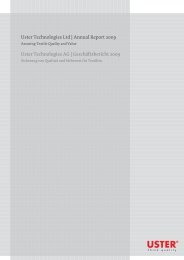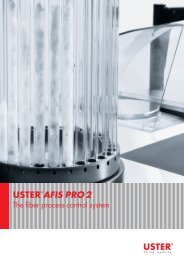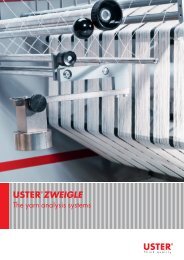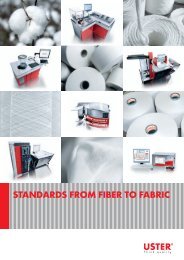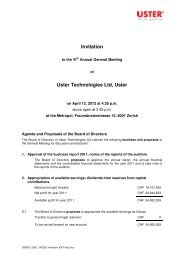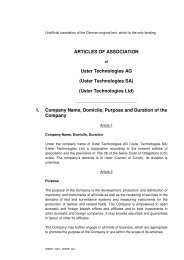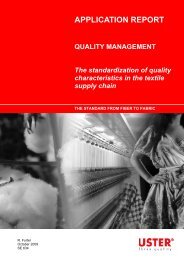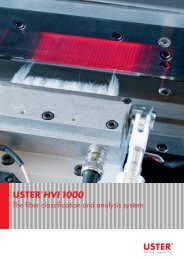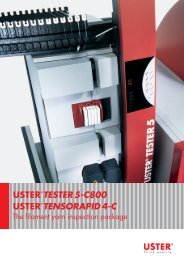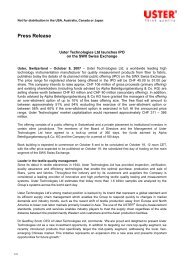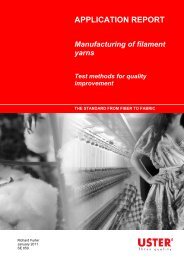Application Handbook_Uster_Statistics - Uster Technologies
Application Handbook_Uster_Statistics - Uster Technologies
Application Handbook_Uster_Statistics - Uster Technologies
- No tags were found...
Create successful ePaper yourself
Turn your PDF publications into a flip-book with our unique Google optimized e-Paper software.
4.2 Fiber ProcessingIn yarn manufacturing of cotton and cotton-based blends, the AFIS ® length, nep, and trash moduleshave been successfully employed to determine raw material properties, to monitor and optimizeproduction machinery, and to replace static, periodic overhaul schedules by flexible, targetedmaintenance. The performance of the opening and cleaning line, of cards, and combers can besubstantially enhanced by analyzing the input/output relationship of fiber length and short fibercontent, neps, and trash. This is accomplished by a modification of the corresponding machineconfigurations, settings, and speeds. Statistical process control techniques provide an opportunity forthe proper timing of maintenance interventions when the parameters monitored by the AFIS ® exceedthe established control limits. The effects of these measures include a substantial improvement of theyarn and fabric quality and a concurrent reduction of operating cost and waste. By identifying andselecting the most suitable cottons for the processing into yarns with the desired quality levels, furthersavings in the field of raw materials can be generated.The cotton fiber processing section of the USTER ® STATISTICS represents a statistical analysis ofin-process AFIS ® measurements which have been performed on a large number of samples drawn atimportant intermediate processing stages: Bale, card mat, card sliver, comber sliver, finisher drawing,and roving.The following is of utmost importance when making a comparison between the results obtained inactual mill processing and the USTER ® STATISTICS: The percentile curves in the fiber processinggraphs connect independent data points. Each data point represents one of the five percentiles (5th,25th, 50th, 75th, and 95th percentile) which have been calculated from all samples from the sameprocessing stage. Therefore, the 50% curve, for instance, does not represent the typical behavior ofan average spinning process; rather, it indicates the theoretical process curve that would be obtainedif the parameters measured at each processing stage would always correspond to the 50th percentile.In practice, we will rarely encounter a spinning process that will exactly track one of the percentilecurves. In addition, the confidence intervals must be taken into consideration. An example relating toAFIS ® neps for a combed ring-spun yarn: A mill processes a raw material with an average of 225±∆xneps/g. This would correspond to the 50th percentile. After opening and cleaning, we find 300±∆xneps/g in the card mat, which represents a point between the 25th and 50th percentile curve. Cardingremoves 75% of the neps and leaves 70±∆x neps/g in the card sliver. Again, this nep count ispositioned in close vicinity to the 50th percentile curve. Our mill ends up with 23±∆x neps/g in thecombed sliver and is back on the 50% curve. The USTER ® STATISTICS on through-the-mill neplevels can also be used in conjunction with a USTER ® MN 100 stand-alone nep tester.When making an assessment of the manufacturing process, it is equally important to consider theoverriding influence of the raw material. Machine performance is not independent of the raw material.Experience proves that in the majority of all cases, poor processing results are to some extent relatedto the fibrous material processed. Textile machines are meticulously engineered products. If they arewell maintained, operated at moderate speeds and with appropriate settings, they will deliverexcellent quality provided sufficient know-how has also been put into the selection of adequate rawmaterials. The effect of raw materials is also indirectly represented in the USTER ® STATISTICSgraphs on fiber processing. It is a well-known fact, for example, that some cottons or cotton mixes aremore prone to nep formation in opening and cleaning than others. The tendency towards nepformation is particularly critical with very fine or immature fibers, i.e. fibers with lower bending rigidity.Likewise, there are cottons which have a tendency to more strongly resist nep removal in carding.Less mature cottons will also suffer more pronounced fiber damage during mechanical processingand exhibit a higher short fiber content. The absolute breaking strength of such fibers is much lowerdue to the lack of cellulose in the fiber cell wall. The actual reduction of the short fiber content incombing is clearly dependent on the percentage of short fibers present in the raw material and thus inthe lap prior to combing.USTER ® STATISTICS 16 (36)



